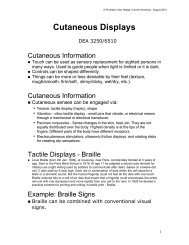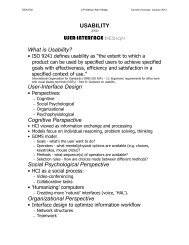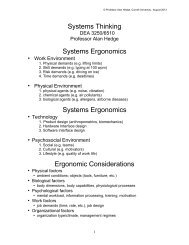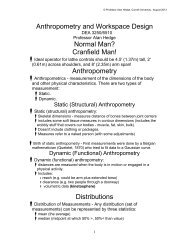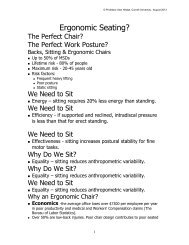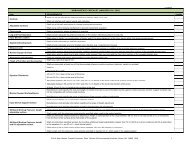Hospital Emergency Room Ergonomic Evaluations ...
Hospital Emergency Room Ergonomic Evaluations ...
Hospital Emergency Room Ergonomic Evaluations ...
- No tags were found...
You also want an ePaper? Increase the reach of your titles
YUMPU automatically turns print PDFs into web optimized ePapers that Google loves.
Cornell <strong>Ergonomic</strong> Consultants<strong>Hospital</strong> <strong>Emergency</strong> <strong>Room</strong><strong>Ergonomic</strong> <strong>Evaluations</strong> &RecommendationsKarleigh BurnsJanna BurrowsChris MoeLily NirenbergCourse taught by Professor Alan HedgeDEA 470, Spring 2004
IntroductionComputers & SeatingGurneysBackboardsWork PatternsAction Items and ConclusionCornell <strong>Ergonomic</strong> Consultants
IntroductionTo RadiologyKey IssuesComputers& SeatingGurneysBackboardsWork PatternsTriageNurse’s StationLevel of ImportanceLowMediumHighEntranceCornell <strong>Ergonomic</strong> Consultants
Computers & SeatingTo RadiologyKey IssueComputers& SeatingTriageNurse’s StationEntranceCornell <strong>Ergonomic</strong> Consultants
Computers & Seating - TriageCurrent Issues•Monitor and keyboard offset inrelation to desk•Trash bin location•Awkward relationship betweenpatient chair and desk•Keyboard and mouse too high –causes wrist extensionCornell <strong>Ergonomic</strong> Consultants
Computers & Seating - TriageRecommendationsTrash• Users eyes 2”- 3”below top ofmonitor casing, facing keyboardand monitor straight on• Monitor placed approximatelyarm’s-length• Tilt-down keyboard and mousetray• Computer stand placed 28”-30”above floor to replace desk• Separate stand for phone andfiles, could swivel into place• Position stand 90° from currentdesk position to face patient• Use tablet PC or laptop tominimize spaceCornell <strong>Ergonomic</strong> Consultants
Computers & Seating – Movable ComputerCurrent Issues• Monitor distance andkeyboard placement createneck flexion• Need to use while standing• Wheels difficult to lock andunlock– Leads to nurses using one footto stabilize and the other tostand (see next slide)• Difficult to adjust height• Requires 31.5 lbs of forceCornell <strong>Ergonomic</strong> Consultants
Computers & Seating – Movable ComputerRecommendations• With this computer stand:• Suggested typing course• Permanent placement inexamination rooms so thatwheels can always be locked• Other options:• Different type of stand with• Locking wheels• Adjustable height• Leg space to allow user to sitdown comfortably• Carry laptop, tablet PC, PDAaround; use with permanentdesks/standsCornell <strong>Ergonomic</strong> Consultants
Computers & Seating – Nurse Work <strong>Room</strong>Current IssuesDesk spacedecreasesavailablespace forprinterPrinter underdesk does notallow roomfor chairTray does notfit keyboardPositivekeyboard tiltleads tocompressionon wristsNeck tiltedto rightCornell <strong>Ergonomic</strong> Consultants
Computers & Seating – Nurse Work <strong>Room</strong>RecommendationsCreate opportunity for nurses tobe seated to provide a brief rest• Align monitor directly in frontof seated employee at an arm’slength away• Remove wooden structure toallow printer and tower to bemoved to the left of themonitor• Install new negative tiltingkeyboard and mouse tray,which will help prevent carpaltunnel syndrome• Provide seating as outlined infollowing slides by removingprinterCornell <strong>Ergonomic</strong> Consultants
Computers & Seating – SeatingCurrent IssuesNo availablearm restsSeat pan is too deep,which causescompression behind theknees and does notallow feet to rest evenlyon the floor. This thenleads to inadequatelumbar support.Difficult to adjust – shouldbe able to adjust in seatedpositionCornell <strong>Ergonomic</strong> Consultants
Cornell <strong>Ergonomic</strong> ConsultantsComputers & Seating – SeatingRecommendations• Chair dimensions will accommodatewidest possible range of employees bymeeting theses criteria:– Seat pan width: 18.3” plus 1” forclothing on each side– Back rest width: 20.6”– Depth of seat pan: 16”– Height of chair: 14.5” – 19”• Chair height should be easilyadjustable while user is seated. Usershould be able to firmly place theirfeet on the ground and their legsshould be parallel with the ground.• Comfortable cushioning on seat panand proper lumbar support• Backrest should recline so the anglebetween upper and lower body is 110°
GurneysTo RadiologyKey IssueGurneysTriageNurse’s StationEntranceCornell <strong>Ergonomic</strong> Consultants
GurneysCurrent Issues•Awkward grip to push backrest down•High force needed to maneuver•Approximately 40lbs without a patient•Awkward balance to lock wheels•High force needed approximately 50lbswith a patient•Dimensions•Width: 29”•Length: 70.5”•Patient weight capacity up toapproximately 300lbs•According to REBA calculations risk is highand action is necessary soonCornell <strong>Ergonomic</strong> Consultants
GurneysRecommendations•Maneuverability•Hydraulic Mechanical lift: to raiseand lower, also for backrest•Better grips•Hand mechanism to lock wheels•Suggested dimensionsGendron 1190•Width: 37”•Length: 70”-80”•Patient weight capacity up to 1000lbsCornell <strong>Ergonomic</strong> Consultants
BackboardsTo RadiologyKey IssueBackboardsTriageNurse’s StationEntranceCornell <strong>Ergonomic</strong> Consultants
Backboards – Pro-Lite SpineboardCurrent IssuesSpecifications:•Weight 11.5 lbs: Unlimitedsingle-patient weight capacity•72" long• 16" wide: Tapers from 16"to14" at foot end•2-1/4" thick• Contour grip offers rescuercomfort on all 16 of the 2" x 5-1/4" holds• One of the more expensiveoptions•Specifications are standardTo be Improved:•Height is 2” longer than adult average•Width is 2.3” shorter than adult average•Grip does not offer enough clearance whenthere is person wider that 16”Cornell <strong>Ergonomic</strong> Consultants
Backboards – Pro-Lite SpineboardRecommendationsPossible Grip Design•To improve:•Off-set grip to allow for maximization ofhold on the backboard•Should be easily stored and maneuvered –possibly foldable•Suggested dimensions to accommodate 99 thpercentile•Men•Shoulder width: 20.6”•Hip width (hip sit): 16.9”•Height: 75.6”•Women•Shoulder width: 18”•Hip width: 16.8”•Height: 69.8”Cornell <strong>Ergonomic</strong> Consultants
Work Patterns – <strong>Emergency</strong> <strong>Room</strong>To RadiologyKey IssueWork PatternsTriageNurse’s StationEntranceCornell <strong>Ergonomic</strong> Consultants
Work PatternsCurrent Issues•Lack of work surfaces atappropriate heights•High Traffic areas used asstorage areas•Lack of storage space•Inefficient space useCornell <strong>Ergonomic</strong> Consultants
Work PatternsRecommendations•Radial layout - Everything is centrallylocated•Minimal movement because of centralproximity to patient areas and workareas with visual access to all rooms•Core area contains: nurses station,charting, lab, clerical, supplies•Increases efficient of space utilizationand traffic flow•Increased work surfaces at two heightsthat can accommodate both sitting andstandingCornell <strong>Ergonomic</strong> Consultants
•Anti-fatigue matsWork PatternsRecommendations•Reduce fatigue and discomfort in legs and back•Increase blood flow and amount of oxygen reachingthe heart•Allows for frequent changes and variability of bodyorientation•Polypropylene stain-resistant surface for ease ofmaintenanceCornell <strong>Ergonomic</strong> Consultants
Action Items and ConclusionTo RadiologyIssues KeyComputers& SeatingGurneysBackboardsWork PatternsTriageNurse’s StationEntranceCornell <strong>Ergonomic</strong> Consultants
Action Items and ConclusionComputersIssue Level of Importance ActionTriageMoveable ComputerNurse Work <strong>Room</strong>SeatingGurneysBackboardsWork Patterns•Rearrange work area•Improve stand usage•Tablet computers•Rearrange work area•Easily adjustable•Proper support•Improved maneuverability•Increased dimensions•Increase size•Improved grip•Radial Layout•Anti-Fatigue matsCornell <strong>Ergonomic</strong> Consultants



